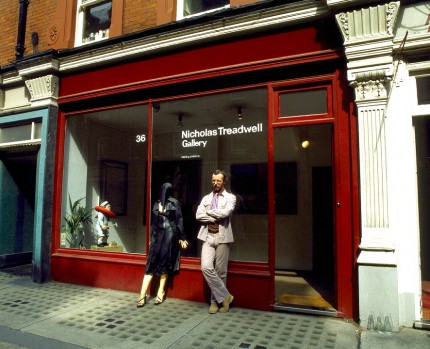1968 – 1984. Chiltern Street was considered to be the wrong side of Oxford street for a successful gallery. It was like village in the middle of London with an assorted collection of shops which had three storeys of flats above them. As well as my gallery and a few trendy fashion shops, it had a pub, a cafe and a newsagents. No 36 was was an intriguing space, made up of a series of small rooms, corridors, nooks and crannies, on the ground floor and basement, with an apparently modest looking old fashioned shop front. For twelve years of my gallery`s seventeen years occupation, my home was a small downstairs room, once referred to by the Sunday Times as a “Converted broom cupboard”. From the mid sixties, continuing on to my moving to Chiltern street, instinctively I collected around me the eccentric, the misfits , the rebels of the British art world, many of them thought too vulgar and passed on to me by other galleries, or those graduates of British Art Schools who stood out in their treatment of what might be seen as the tabu aspects of the human condition. Looking at the progress of British art into the nineties(Sensationalism, for instance) and the early 21st century, in terms of the development of British art, I believe my beloved Chiltern Street Gallery could be seen to have had a seminal influence. It was controversial, it`s provocative style brought much negative criticism, as well as positive (“Nicholas Dreadful Gallery” “Worst Gallery in London” – Both from Time Out`s Sarah Kent. ) (“A phenomenon in British Art” The Sunday Telegraph`s Michael Shepherd. “This Supercharged group has extended the boundaries of figurative art, laid during two decades of Pop Art and Photo Realism – Art and Artist. “…the liveliest on the British – indeed the European scene” the Australian) “…One of the most successful and hated galleries in the world” City Limits, London`s other Listings Magazine in 1984 (Yes really!)
